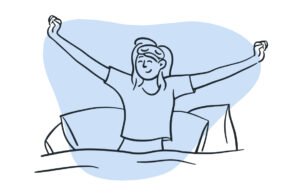I Tried Living Like a Bear Chronotype for a Week
Disclosure: By clicking on the product links in this article, Mattress Nerd may receive a commission fee at no cost to you, the reader. Read full disclosure statement.
I tried living like my chronotype for a week. This meant I had to change the time I woke up, went to sleep, ate meals, and exercised for a whole week. All these changes were made to best suit my chronotype: the bear.
Your chronotype represents the times you like to wake up and go to sleep, as well as be productive. I wanted to see if following a schedule designed specifically for the bear chronotype would benefit my productivity, energy, and sleep.
@mattressnerd One of our staff writers, Celia, changed her daily routine to match the schedule of a bear chronotype. Read Celia’s article about sleep chronotypes, and learn more about how to find out which “type” you are, by visitng the link in our bio 🔗😴🐻 #sleepchronotype #bearchronotype #sleep #experiment #dayinthelife #vlog #dailyroutine
♬ Chillout Lofi Hip Hop F(884707) – musicabeats
What are Chronotypes?
Chronotype is your tendency or predisposition to want to go to sleep and wake at a certain time. This means that your body has a time that it wants to wake up every morning and go to sleep every night.
Normally, one’s chronotype is placed into two large categories: night owl and early bird. To learn more about the science behind chronotypes, check out our interview with a sleep psychologist.
Dr. Michael Breus created a popular system where he compares sleep patterns of chronotypes to animals. There are four potential animals you could identify as: bear, lion, wolf, or dolphin. What animal you are depends largely on when you like to wake up and when you like to go to sleep.
Which Chronotype am I?
There are countless online quizzes to see which animal your chronotype relates to. However, differing results are common. I had to take so many different quizzes from different sites before I felt confident in my results.
In the end, I discovered that I am a bear. You might not know exactly what that means, so we included a description of the bear chronotype to see if you are one, too.
Bear
The bear is a very common chronotype, so chances are you may fall into this category. Bears are morning people who are most productive before noon. They begin to experience energy and productivity declines in the afternoon, resulting in earlier bedtimes.
The good news for bears is that society is built around their prime sleeping, waking, and productive times. They’re able to go to sleep and wake up when your body wants, and still operate accordingly in society.
Since the peak productivity time is earlier in the day, a good tip for bears is to try and get your harder tasks done earlier in the day. This means bears should save easier and less straining work for later when they start to lose steam.
Dr. Breus expanded on his ideas in a TedTalk, where he explained a few more qualities bears are likely to have. He said that bears are likely to be extroverted and open-minded people and that they are the glue for society because they get work done.
Living like the Bear Chronotype
I decided to try out living like my chronotype for a week to see if listening to my body and the science of chronotypes would lead to improvements in my life. I followed schedules for the bear chronotype from Casper, and supplementary times for eating, exercising, and caffeinating from a TedTalk by Dr. Breus.
Daily Schedule of the Bear Chronotype
- Wake up: 7:00 a.m.
- Workout (option 1): 7:30 a.m.
- Breakfast: 7:30 a.m.
- First Caffeine: 9:30 a.m. – 11:30 a.m.
- Prime Work and Productivity: 10:00 a.m. – 2:00 p.m.
- Lunch: 12:30 p.m.
- Workout (option 2): 12:30 p.m.
- Second Caffeine: 1:30 p.m. – 3:30 p.m.
- Lighter Work and Tasks: 2:00 p.m. – 4:00 p.m.
- Unwind and Destress: 4:00 p.m. – 10:00 p.m.
- Dinner: 7:30 p.m.
- Sleep: 11:00 p.m.
Working
Bears should schedule their harder and more difficult tasks for the morning time, as our prime time for deep work is 10 a.m. to 2 p.m. We tend to lose energy and steam in the afternoon, so it makes sense to do easier and less difficult tasks then.
I have always known that I like to get my work done earlier in the day, preferably in the morning, so this was a very simple thing to implement. Now that I know there is science behind this habit of mine, it makes me feel better for experiencing a bit of an afternoon slump (as long as I get work done in the morning).
Eating
Breakfast – 7:30 a.m.
There are a few contradicting times in the schedules, which makes following an online schedule a little difficult. How am I supposed to work out and eat breakfast at the same time? These overlaps led to a bit of improvisation on which activity to do first.
I decided to eat breakfast after my workout since I’m usually not that hungry when I wake up. This decision seemed to work great for my energy levels. Eating before I began to work helped me to optimize my prime working hours of 10 a.m. to 2 p.m. I didn’t need to take both a breakfast and lunch break in this peak productive time to keep energy levels high, saving me time and productivity.
Lunch – 12:30 p.m.
Conveniently, the bear lunch time overlaps with my lunch break. This made it very easy to follow the bear chronotype eating pattern for lunch. As mentioned earlier, the world operates according to the bear chronotype, which makes listening to your body convenient and straightforward (most of the time).
Dinner – 7:30 p.m.
Again, dinner was very easy to implement for the bear chronotype, as Americans on average eat dinner around 6 or 7 p.m. Although it’s a little later than average, I found it both socially acceptable and natural for my hunger levels to eat at 7:30 pm.
Caffeine
When to Drink Caffeine
- Morning: 9:30 – 11:30 a.m.
- Afternoon: 1:30 – 3:30 p.m.
Dr. Breus recommends that bears have their first cup of coffee around 9:30 a.m. to experience caffeine’s maximum effect. As someone who normally drinks coffee first thing in the morning, it was difficult to wait, but I did so for this journey.
Why Wait to Drink Coffee?
When you first wake up, your level of cortisol, a stress hormone, spikes to help pull you out of unconsciousness. This peaks about half an hour to 45 minutes after you wake up, and then comes back down. Waiting to have caffeine can help keep your energy levels balanced by adding caffeine at about the time that your hormone levels decrease.
Exercise
- 7:30 a.m. or 12:30 p.m.
With the advised times from Dr. Breus, I set out to exercise every morning this week at 7:30, before work. I have never been someone who wakes up early to get a workout in before starting their day, but I wanted to try it this week to see if it would give me better energy levels and sleep.
It was more difficult on the weekends to motivate myself to get up and going, so I opted for exercise at 12:30 p.m. I played pickleball with my family one day and on the other, I went for a long walk. Having these two windows of exercise really helped me not feel so trapped in this lifestyle and realize that it is adaptable to my life.
This allows me to personalize the bear schedule a little to my own liking. Living like the bear chronotype doesn’t mean you have to follow a schedule so rigidly and without thought. Remember: listen to your body.
Reflections on Living Like a Bear Chronotype
7 a.m. Wake up
Getting out of bed right when I wake up has been the hardest part of this schedule. Although my alarm normally goes off around 7 a.m., I will stay in bed on my phone and slowly persuade myself from the covers with the promise of coffee. Living like a bear means I have to get right out of bed at 7 a.m. and hit the gym with no caffeine in my system.
The 7 a.m. wake-up time, according to the bear chronotype, has allowed me to see how much I benefit from waking up and exercising. I have always thought that I would be way too tired to work out before my morning coffee, but it is honestly quite enjoyable and rewarding.
Wait for Coffee
Although this has been difficult, I believe that this routine has weakened my dependence on coffee. Once I finish my workout and shower to begin the day, I feel quite awake and alert naturally. I do still crave some caffeine right when I wake up, to give me energy in the gym, but what I have realized is that I slowly start to wake up once I start moving.
With the later and multiple windows for caffeine in a day for a bear, I believe I am able to stay at the peak of my energy levels for longer. Since adhering to the advice to wait for my cortisol and adrenaline levels to drop, I am able to not lose steam only an hour or so after my coffee.
Consistency
You might have heard the statement that it takes 30 days to build a habit. This means that if you want to implement any of these habits to match your chronotype, then just be aware it may take some time. Even though I saw the benefit of waking up early and working out, it is still hard to follow through with it every day because it is not my typical routine.
However, with every day that I implement the changes (such as exercising first thing, waiting to drink coffee, and scheduling harder tasks in the morning), it becomes easier. I think it is important to keep consistency in these habits to live like your chronotype if you truly want to see changes and benefits.
How to Live Like Your Chronotype
Interested in trying to live like your chronotype? Here are our top tips on making it happen.
1. Find your chronotype
There are many online quizzes and descriptions to find out what chronotype you are. Be prepared that you may need to take a few (as differing results are common). Trust what you think it’s best because you know yourself and your sleep habits better than a website.
2. Set a Wakeup and Bedtime
The times each chronotype wakes up and goes to sleep each night are important and unique to each chronotype. Bears and lions prefer to wake up earlier and go to sleep earlier. However, wolves like to stay up late and sleep in.
Make sure that whatever time you set your alarm every morning allows you to get the right amount of sleep and operate in society, as needed.
3. Stay Consistent
If you want to try to leverage the potential benefits of living your life according to your chronotype, you need to stay consistent in your habits and schedule. This means the more closely you can stick to your wake-up and bedtimes – even on weekends – the more likely it is that you’ll get used to the routine.
Source List
- Dowd JB, et al. (2011). Education and levels of salivary cortisol over the day in U.S. adults. https://www.ncbi.nlm.nih.gov/pmc/articles/PMC3486742/#R9

